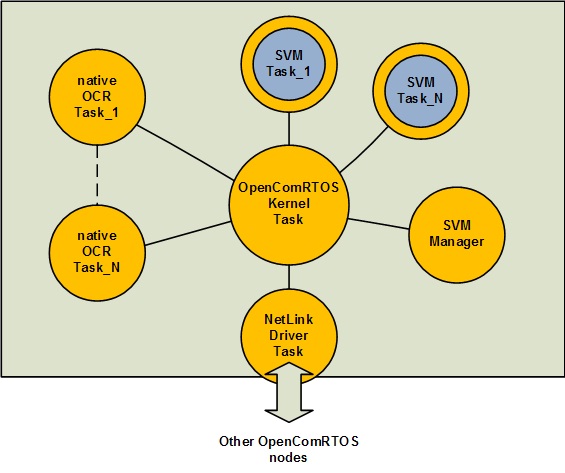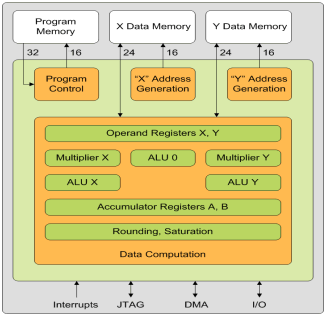You are hereAltreonic’s scalable and formalized technology gives more for less.
Altreonic’s scalable and formalized technology gives more for less.
Altreonic is now announcing two new products that clearly demonstrate how a formalized development can result in more scalability and less energy consumption. First we present our brand-new Safe Virtual Machine for C in just 3.8 KB. Next we present a port to the ultra low power CoolFlux DSP core of NXP. Formalized development is more than verifying correctness, it actually results in cleaner, more efficient and more scalable architectures.
Virtual Machine for C in 3.8 KBytes
 A first example is Altreonic’s novel Safe Virtual Machine for C (SVM). Tuned to the needs of embedded systems it allows to dynamically download C compiled binary code to OpenComRTOS nodes independently of the target processor. Yet, the Virtual machine only requires 3.8 Kbytes of program memory (measured on an ARM Cortex M3).
A first example is Altreonic’s novel Safe Virtual Machine for C (SVM). Tuned to the needs of embedded systems it allows to dynamically download C compiled binary code to OpenComRTOS nodes independently of the target processor. Yet, the Virtual machine only requires 3.8 Kbytes of program memory (measured on an ARM Cortex M3).
Every processing node in an OpenComRTOS supported system can host multiple Safe Virtual Machine tasks, each of these can use the native kernel services and hence communicate system wide. SVM tasks can also be unloaded, updated at runtime, as well as be moved between networked OpenComRTOS nodes. For safety purposes the Virtual Machine can verify memory accesses and catch boundary violations and numerical exceptions at runtime.
As the VM is based on the ARM Thumb2 instruction set, it is also possible to execute the binary images in native mode on most of the ARM processors. While VM tasks execute slower than native code, the performance is adequate given the intended range of applications. Typical applications for the SVM are remote diagnostics, fail safe, fault tolerant control, and processor independent programming.
Full OpenComRTOS on CoolFlux DSP in just 2 Kwords.
 A second example is the port of OpenComRTOS to the ultra low power CoolFlux DSP core of NXP. A full kernel with all services only requires about 2 Kwords for program memory and less than 1 Kwords of data memory. Nevertheless, this is still a complete priority based preemptive scheduling RTOS. Besides task scheduling, services provided are events, semaphores, resources, port hubs, fifos, packet and memory pools in blocking, non blocking, blocking with timeout and asynchronous semantics.
A second example is the port of OpenComRTOS to the ultra low power CoolFlux DSP core of NXP. A full kernel with all services only requires about 2 Kwords for program memory and less than 1 Kwords of data memory. Nevertheless, this is still a complete priority based preemptive scheduling RTOS. Besides task scheduling, services provided are events, semaphores, resources, port hubs, fifos, packet and memory pools in blocking, non blocking, blocking with timeout and asynchronous semantics.
For applications where power consumption is paramount, using less memory means higher performance and less energy consumption. With OpenComRTOS, this is a result of the formalized development resulting in a very clean architecture. In addition, with OpenComRTOS one can transparently use a multicore architecture allowing to distribute the application. If this allows to reduce the clock frequency, thus even more power can be saved. Porting on CoolFlux DSP has been swift and efficient thanks to the excellent C-language support from the CoolFlux DSP tools originating from Target Compiler Technologies.
The OpenComTOS suite consist of the high level visual development environment (OpenVE) in which the user specifies applications and target topology in an independent way allowing to simulate the application on his development PC. Code generators than generate most of the target specific C code and the build system. A new task level debugger and the visual OpenTracer allow to examine and profile the application at runtime.
Interested readers who want more details or who want to consider application specific designs are invited to contact us at info.request (@) Altreonic.com
More information can be found at following links:
- Safe Virtual Machine for C product leaflet
- http://www.coolflux.com for the CoolFlux DSP core
| Attachment | Size |
|---|---|
| Altreonic Safe Virtual Machine_C_2010.pdf | 224.01 KB |
- Printer-friendly version
- Login to post comments